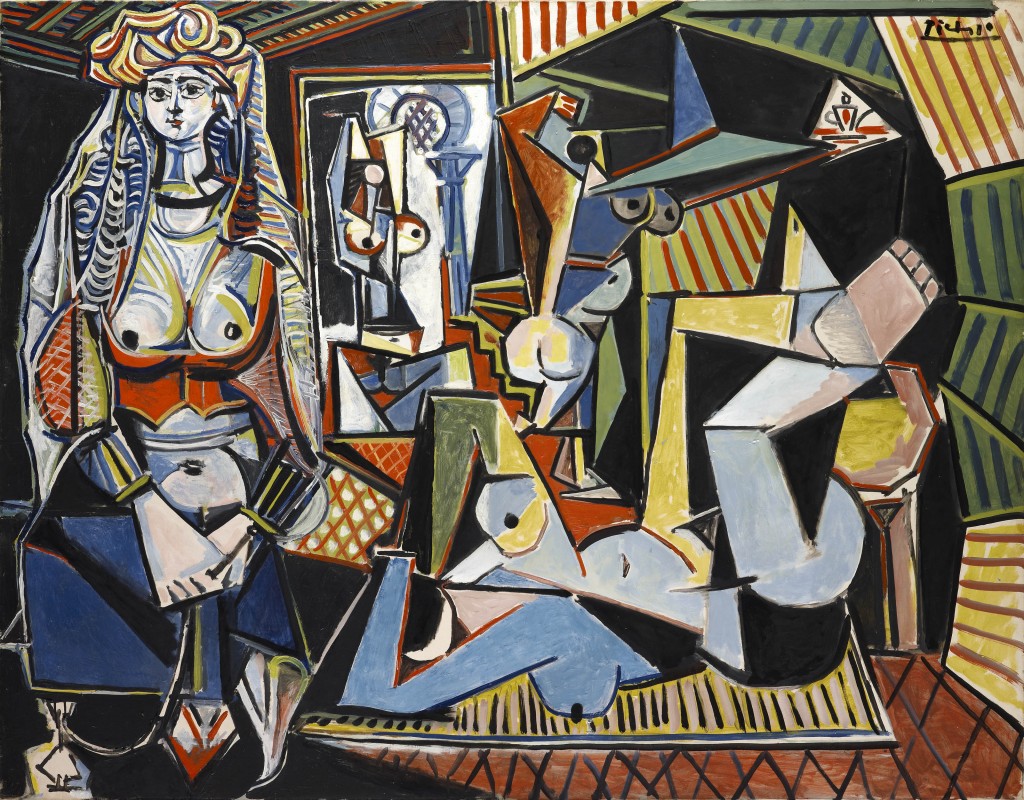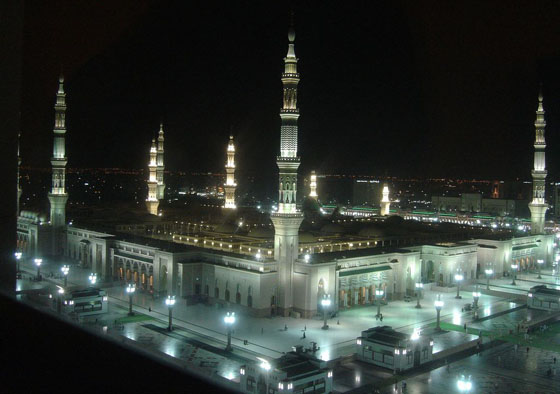Leonardo
da Vinci's works such as "The Lady with an Ermin," above, can be seen
in 'Leonardo da Vinci: Painter at the Court of Milani.' Below: A crew
sets up.
Last November, when the National Gallery in London opened the exhibition “Leonardo da Vinci: Painter at the Court of Milan,” people lined up around the block before dawn in the hope of getting tickets. And then they did it again, the next day. And the next.
So many people wanted to see the show because it was such a rare event: It was the first exhibition in modern times devoted to Leonardo as an artist, not as scientist or architect or anatomist or aeronautics engineer or, often enough, plain old wizard. And it brought together more of his paintings in one spot (probably) than at any time since they were painted: Of the 15 or so widely accepted oils that survive by Leonardo, about half are included. The paintings are so valuable and so fragile that it’s unlikely they will ever be seen together again, certainly not in our lifetimes.
And since so many people were unable to get tickets for “Painter at the Court of Milan,” which closed two weeks ago, a high-definition film that walks through the exhibition, shot the day before its official opening, will be released in more than 500 theaters across the United States today, including more than a dozen theatres in New Jersey.
The excitement for this particular show is easily explained. In a cluster of small basement galleries, the National had installed two ravishing portraits of women, the “Lady with an Ermine” and “La Belle Ferronniere,” both believed to have been involved with Leonardo’s patron, the Milanese usurper Ludovico Sforza; the almost complete portrait of a handsome young man known as “The Musician”; the unusual “The Madonna Litta,” from the Hermitage in St. Petersburg; and both versions of “The Madonna of the Rocks.” The largely unfinished “St. Jerome” is also here.
Britain’s royal collection houses most of the best-known of Leonardo’s drawings, including the cartoon of “The Virgin and Child with St. Anne and St. John the Baptist,” and for this show they’ve brought out 33 of the finest plus another 17 on loan from institutions around the world. The famous sketches for the heads of the apostles have been placed around the finest contemporary copy of “The Last Supper,” by Il Giampetrino. Disputed or uncertainly attributed pictures, like “Christ as Salvator Mundi,” sometimes ascribed to Boltraffio, are also included.
The greatest curatorial coup was bringing the National Gallery’s version of “Madonna of the Rocks” into proximity with the Louvre’s version of the same picture. Both were attributed to Leonardo in his lifetime, and the pictures are remarkably similar. But most experts who’ve seen “Painter at the Court of Milan” now agree that only the Louvre version is entirely by Leonardo’s hand, and the British version is an authorized copy by Ambrogio de Predis, in which the master had only limited participation — though he took his full share of the payment for its delivery.
“Leonardo Live” is hosted by the very British-sounding pair of art historian Tim Marlow and TV presenter Mariella Frostrup. It documents not only the arrangement of the pictures and their careful lighting, but also the relatively radical step of carving and gilding new frames for many of the pictures in a faux 16th-century style. And it tries to get at the mysterious fascination Leonardo can still exert across half a millennium.
Where to see it
“Leonardo Live” will be shown in 500 movie theaters around the country with screenings today only at select venues in New Jersey. Showtime at most theaters is at 7 p.m. For a complete list of theaters or to buy tickets online, visit fathomevents.com.
• Digiplex Cranford 25 North Ave., Cranford (908) 276-9120
• AMC Clifton Commons 16 405 State Route 3, Clifton (973)614-0966
• Showplace Theatre 650 Plaza Drive, Seacaucus (201) 210-5364
• Commerce Center 18 2399 Route 1, North Brunswick (732) 940-8361
• AMC Garden State 16 1 Garden State Plaza, Paramus (201) 291-8414
• AMC Rockaway 16 363 Mount Hope Ave., Rockaway (973) 328-4255
• Edgewater 16 Multiple Cinemas 339 River Road, Edgewater (201) 840-6665
• AMC Hamilton 24 325 Sloan Ave., Trenton (609) 890-7937
Leonardo da Vinci’s works such as The Lady with an Ermin, above, can be seen in “Leonardo da Vinci: Painter at the Court of Milani.” Below: A crew sets up.
Last November, when the National Gallery in London opened the exhibition “Leonardo da Vinci: Painter at the Court of Milan,” people lined up around the block before dawn in the hope of getting tickets. And then they did it again, the next day. And the next.
So many people wanted to see the show because it was such a rare event: It was the first exhibition in modern times devoted to Leonardo as an artist, not as scientist or architect or anatomist or aeronautics engineer or, often enough, plain old wizard. And it brought together more of his paintings in one spot (probably) than at any time since they were painted: Of the 15 or so widely accepted oils that survive by Leonardo, about half are included. The paintings are so valuable and so fragile that it’s unlikely they will ever be seen together again, certainly not in our lifetimes.
And since so many people were unable to get tickets for “Painter at the Court of Milan,” which closed two weeks ago, a high-definition film that walks through the exhibition, shot the day before its official opening, will be released in more than 500 theaters across the United States today, including more than a dozen theatres in New Jersey.
The excitement for this particular show is easily explained. In a cluster of small basement galleries, the National had installed two ravishing portraits of women, the “Lady with an Ermine” and “La Belle Ferronniere,” both believed to have been involved with Leonardo’s patron, the Milanese usurper Ludovico Sforza; the almost complete portrait of a handsome young man known as “The Musician”; the unusual “The Madonna Litta,” from the Hermitage in St. Petersburg; and both versions of “The Madonna of the Rocks.” The largely unfinished “St. Jerome” is also here.
Britain’s royal collection houses most of the best-known of Leonardo’s drawings, including the cartoon of “The Virgin and Child with St. Anne and St. John the Baptist,” and for this show they’ve brought out 33 of the finest plus another 17 on loan from institutions around the world. The famous sketches for the heads of the apostles have been placed around the finest contemporary copy of “The Last Supper,” by Il Giampetrino. Disputed or uncertainly attributed pictures, like “Christ as Salvator Mundi,” sometimes ascribed to Boltraffio, are also included.
The greatest curatorial coup was bringing the National Gallery’s version of “Madonna of the Rocks” into proximity with the Louvre’s version of the same picture. Both were attributed to Leonardo in his lifetime, and the pictures are remarkably similar. But most experts who’ve seen “Painter at the Court of Milan” now agree that only the Louvre version is entirely by Leonardo’s hand, and the British version is an authorized copy by Ambrogio de Predis, in which the master had only limited participation — though he took his full share of the payment for its delivery.
“Leonardo Live” is hosted by the very British-sounding pair of art historian Tim Marlow and TV presenter Mariella Frostrup. It documents not only the arrangement of the pictures and their careful lighting, but also the relatively radical step of carving and gilding new frames for many of the pictures in a faux 16th-century style. And it tries to get at the mysterious fascination Leonardo can still exert across half a millennium.
Where to see it
“Leonardo Live” will be shown in 500 movie theaters around the country with screenings today only at select venues in New Jersey. Showtime at most theaters is at 7 p.m. For a complete list of theaters or to buy tickets online, visit fathomevents.com.
• Digiplex Cranford 25 North Ave., Cranford (908) 276-9120
• AMC Clifton Commons 16 405 State Route 3, Clifton (973)614-0966
• Showplace Theatre 650 Plaza Drive, Seacaucus (201) 210-5364
• Commerce Center 18 2399 Route 1, North Brunswick (732) 940-8361
• AMC Garden State 16 1 Garden State Plaza, Paramus (201) 291-8414
• AMC Rockaway 16 363 Mount Hope Ave., Rockaway (973) 328-4255
• Edgewater 16 Multiple Cinemas 339 River Road, Edgewater (201) 840-6665
• AMC Hamilton 24 325 Sloan Ave., Trenton (609) 890-7937
Leonardo da Vinci’s works such as The Lady with an Ermin, above, can be seen in “Leonardo da Vinci: Painter at the Court of Milani.” Below: A crew sets up.











































































